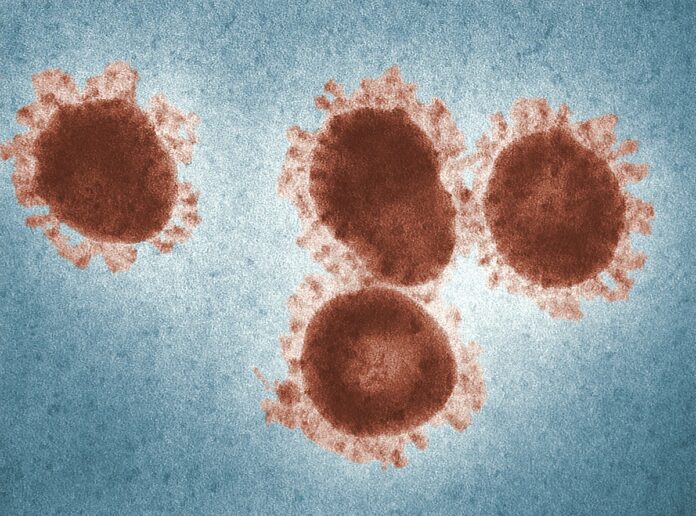With 401 million cases and 5.76 million deaths at the time of writing, COVID-19 has ravaged the world in a way that hasn’t been seen for decades. That being said, this is far from the first pandemic the world has faced. So why were we so unprepared for it? How did people in the past deal with these pandemics? History can be cyclical if we refuse to learn from it.
So what can plagues from the past teach us about the future? Here are some examples of past plagues, their severity, and how they eventually went away.
Plague of Justinian
This first large wave of the bubonic plague appeared in Constantinople in 541 CE. After killing a large portion of the city’s population, the plague spread across Europe, Asia, and North Africa. The death toll is estimated to be anywhere between 30 to 50 million people. It’s hard to know for sure since record-keeping from over 1000 years ago was a bit spotty, but it killed enough people that the fabric of society shifted drastically.
Bodies were stacked indoors and on the streets. Many people thought it was the end of days, which will be a common theme in many of the plagues we discuss today. Sadly, the plague didn’t end through a concerted societal effort. It spent two years ravaging the landscape and eventually fading away after infecting or killing everyone it could.
The Black Death
The bubonic plague didn’t fully go away. It came in waves, and the deadliest wave began in 1347. It lasted about five years and killed around 25 million people. Society came to a halt, as bodies were stacked in the streets, food became scarce, the population was reduced by a third. Additionally, the disease affected people in different ways, sometimes spreading to the blood and lungs, which could largely affect your chances of survival.
So how did the plague finally end? Simple: They invented the quarantine. While they knew next to nothing about how the plague was spread, people were aware they caught it after being in contact with others who had it. So laws were passed that said people with symptoms had to be isolated for 40 days. Makes the 14-day quarantine seem nice now, doesn’t it?
Smallpox
Smallpox was particularly tragic. In Europe, it was a beast on its own. However, when it was brought to the Americas, it wiped out around 90% of the Native American population. Entire histories and civilizations were completely eradicated. They didn’t have a way to fight off smallpox, measles, and other diseases that came from the densely populated, and extremely polluted, cities of Europe.
Smallpox would continue to ravage the Americas as it mutated and evolved. It heavily damaged troops during the American Revolution. It only ended after Edward Jenner, a British doctor, invented a rudimentary vaccine; the first of its kind. People lined up to get it, which has proven to be a challenge during this current pandemic.
Cholera
During the middle of the 19th century, around 1854, Cholera spread through England and killed tens of thousands of people. This epidemic led to an internal investigation of the London sewer system, where it was revealed the water was causing the spread of the disease in the city. Once sewage systems were replaced, the disease disappeared in a matter of months.
Cholera would continue to be a nuisance in other cities with similar sewage issues. Once these issues were corrected, the harm from the disease was largely reduced, but not before killing over a million people.
1918 Flu
Called the Spanish Flu because of a propaganda campaign against Spain, which was the only country that was being honest about their death toll, the 1918 Flu killed an estimated 50 million people. The flu did major damage to the global economy and almost derailed the Paris Peace Conference when Woodrow Wilson caught the disease and had to remain in bed for days on end.
So how did this pandemic end? It was a combination of things. Quarantines and isolation helped a lot, as did people wearing masks. It took the world working together for two years to end this pandemic, and it happened despite propaganda and rampant misinformation campaigns.
These pandemics are vastly different from COVID-19. We now have the technology and know how to deal with these kinds of things much faster. That said, some of these instances are eerily similar. Propaganda and misinformation campaigns helped spread the 1918 Flu worldwide and made it last longer than it should have. Smallpox was bad for everyone, yet it still disproportionately affected vulnerable populations due to ignorance and colonization.
That said, the positives are mirrored too. The scientific breakthroughs saved the day in almost every pandemic we’ve discussed. Vaccines, quarantines, and masks were very widely accepted and helped end these pandemics before they could ravage the world more than they already had.
So what’s different this time? Why has there been so much pushback on measures that could’ve saved so many lives? The answer lies in the way we communicate and get information. Propaganda has always existed, but now misinformation can spread much faster. This means people aren’t able to trust the information they hear, even if it’s proven to have worked in the past.
In terms of plagues, COVID-19 isn’t the deadliest, but it’s currently in the top ten. As the pandemic still rages on, isolation, masks, and vaccines are our best bets at ending this once and for all. The worst-case scenario would be another Plague of Justinian, where the virus only goes away when everyone gets infected and swaths of the population die. We need to learn from the past to protect the future, and that means learning from the mistakes and successes we’ve seen during this current pandemic. The next pandemic is not a matter of “if” but “when.” We need to be ready, and being ready means working together.
Russell is a writer and comic based in New York City. His plays have been featured at Penn State’s Cultural Conversation’s Festival, The NYC Thespis Festival, and Imaginarium’s Inaugural Theater Festival. Follow him on TikTok and Instagram @pooleparty528



